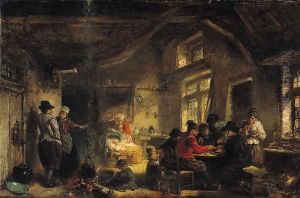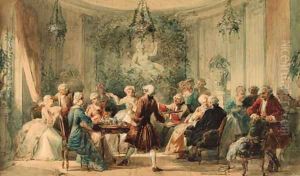Herman Frederik Carel Tenkate Paintings
Herman Frederik Carel Ten Kate was a Dutch painter who was born on February 16, 1822, in The Hague, Netherlands. He came from a family with a strong artistic background, as his father, Jan Herman ten Kate, and his brother, Mari Ten Kate, were also painters. This familial influence inevitably shaped his career and artistic style.
Ten Kate specialized in genre painting, a style of painting that depicts scenes from everyday life, often with a narrative element. He was particularly known for his historical and military scenes, which were inspired by the Dutch Golden Age of the 17th century. His works often featured soldiers, cavaliers, and scenes of public merriment, imbued with a sense of romanticism and drama.
Educated at the Royal Academy of Art in The Hague, Ten Kate honed his skills under the guidance of prominent artists such as Salomon Verveer and Huib van Hove, both of whom contributed to his development as a genre painter. His work was well-received, and he gained recognition for his ability to depict historical accuracy and his attention to detail, particularly in the clothing and settings of his figures.
Throughout his career, Herman Ten Kate was an active exhibitor, showing his work at various exhibitions and winning medals for his paintings. His works were exhibited not only in the Netherlands but also internationally, including cities like Paris and Philadelphia, which was indicative of his reputation at the time.
Aside from his painting, Ten Kate was a member of the Pulchri Studio, an important art society in The Hague that was established to promote the works of its members and encourage the exchange of artistic ideas. This association with other artists helped to sustain his artistic development.
Herman Frederik Carel Ten Kate passed away on December 26, 1891, in The Hague. His legacy lives on through his paintings, which continue to be appreciated for their historical value and their contribution to Dutch genre painting in the 19th century. His works are part of collections in various museums and have been sold at auction houses, maintaining his presence in the art world long after his death.

